When teaching at JMI in Brisbane I get all students to spend some time reviewing some basic fundamentals on the drum kit. Reading rhythms is one skill we can use to help us develop in many ways on the drum kit. Here’s some ideas you may want to try.
Adaptation of Ostinato concept to “Jazz”
There have been a number of great texts written over the years on the development of coordinated independence on the drumset in regard to Jazz drumming.
Advanced Techniques for the Modern Drummer by Jim Chapin is regarded as “the definitive study on coordinated independence” for the jazz drummer and I suggest you check it out. The Art of Bop Drumming by John Riley is also very popular and I regard is the most complete introduction to jazz drumming techniques.
John Ramseys’ The Drummers Complete Vocabulary As Taught by Alan Dawson is also a great text that details the teaching methods developed by Alan Dawson.
The following is an introduction to applying similar concepts to help you develop your ability on the drum set in a jazz style. I suggest you purchase the above mentioned books and study from them. As with all music you need to listen to it to understand the concepts, feel, how and why the drummers are playing what they are playing!
Here’s the most common ostinato used in Jazz.

The role of the snare drum is to “comp” (accompany) that is; create musical dialog and interjection.
A note about the bass drum.
It is a tradition to play four beats on the bass drum at a very low dynamic and is called “feathering. Some musicians like the drummer to do so , others don’t. What ever you do don’t play it too loud. Let it be “felt” more than heard. If your band isn’t digging your bass drum give it a rest!
Another common way to play time is the feel that Papa Jo Jones made famous. It can work for both “2 feels” and “4 feels”:

Note: The swing rhythm is based on triplets. One way to learn the feel is to say:
“lang- spang –a-lang –spang- a”.
Adding Comping
The goal is to add in your comping rhythms without disturbing the flow of the cymbal. You will notice that I have notated the cymbal beat with an accent on beat 2 and 4. I have found that many drummers have trouble keeping the cymbal beat flowing and tend to either accent on beat 1 and 3 or even the “skip” beats when the add in comping. It can help to accent beat 2 and 4 to counter this. You will notice at faster tempos the ride cymbal hand actually “throws” the rhythm down on beat 2 and 4. Playing through every permutation of single 8th notes and subsequently two or more 8th notes will help you coordinate it all. Here’s some examples. Remember theses are all played as swing 8ths.
Single Notes:
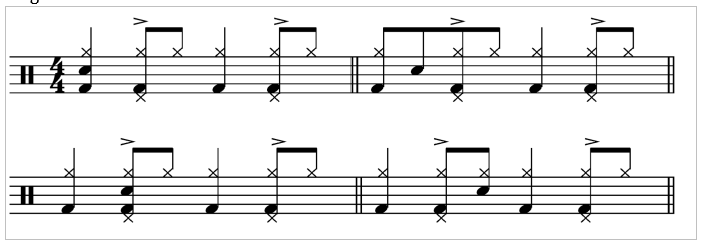
Two Notes:
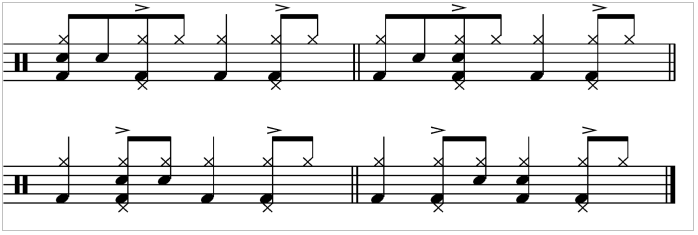
You can try playing the famous page 38 from Syncopation (REED, T). Here’s the 1st four bars of it.
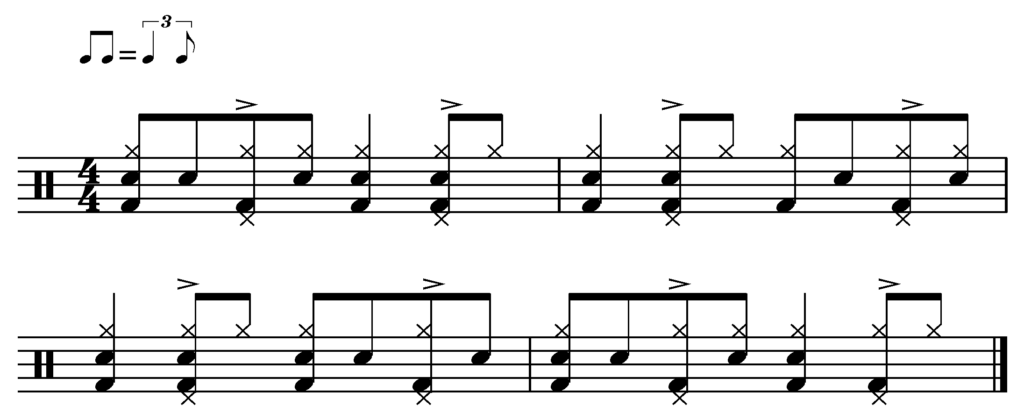
Comping with the bass drum
Bebop pioneers Max Roach and Kenny Clarke developed the use of the bass integrating into the comping role with the snare drum.
The next step is to review playing of rhythms and reading text with the bass drum.
Here are some examples on bass drum:
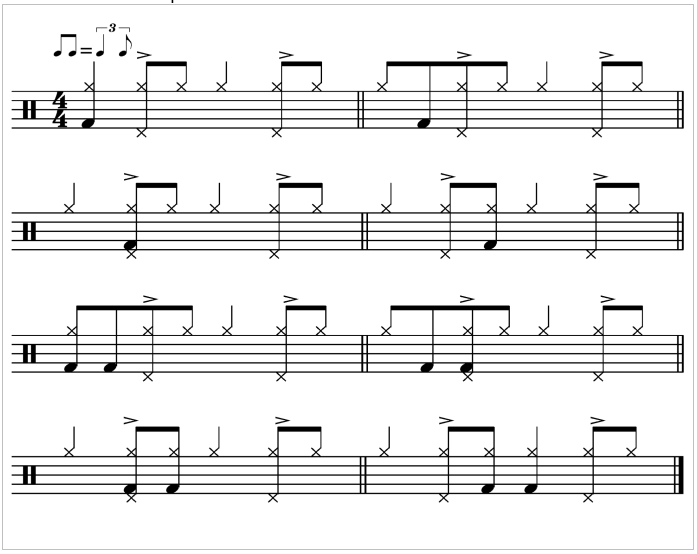
Here’s and example of the bass drum playing through the first line of page 38 in Syncopation (REED, T).
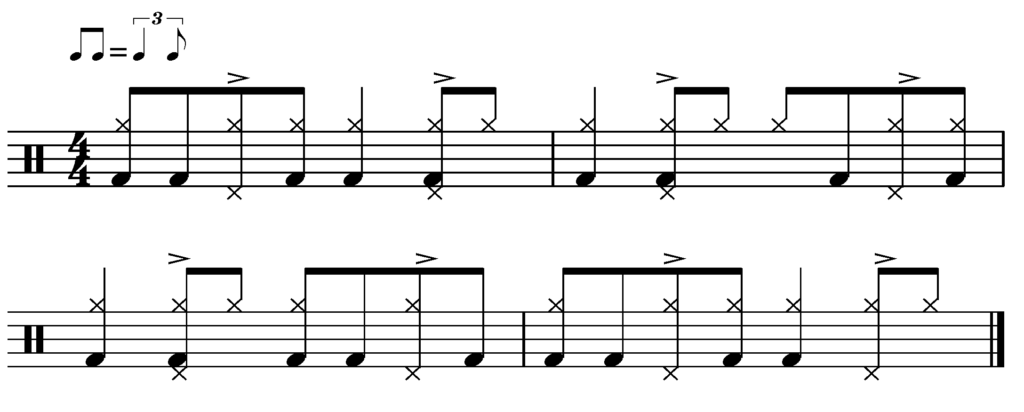
Note: We all know it’s advisable to practice with a metronome. I suggest that for these feels you practice with the metronome on beats 2 and 4.
Application of long and short notes.
The duration of notes matter. Often as drummers this can be overlooked due to percussive nature of the instrument. The different components of the drum kit have long and short sounds. For example the snare drum is short, the cymbals are long. The bass drum may be long or short depending on the tuning and muffling. The Hi hat can feature both long (open) and short (closed) sounds. Various techniques can be employed to sustain or shorten sounds. Playing a buzz roll on the snare drum is an example. We can also choke the cymbals to play short sounds.
Below is a simple exercise to improve how relate written notes to the long and short sounds of the drum kit.
Example text:

When we read the above we interpret the lengths as such.
8ths notes = short sounds = snaredrum
Anything longer than an 8th note = long sound = Ride Cymbal. This will include ¼ notes, tied 8th notes, dotted ¼ notes , 8th notes tied to ¼ notes etc.
The written rhythm will now sound like this:
(including bass drum ¼ notes and Hihat on beat 2 & 4):

It’s always a good idea to always practice the swing interpretation as well:

This concept is not a “look at me” moment. It’s a fundamental concept that will add to a strong musical foundation and help in many ways as you develop as a musician at the drum kit.
Application to playing styles
We can apply this concept to help us develop the coordination needed to play our “comping” in a Jazz style.
While playing this ostinato:

We play through reading text:

We now and read the short notes on the snare drum and the long notes on the bass drum.
It will sound like this:
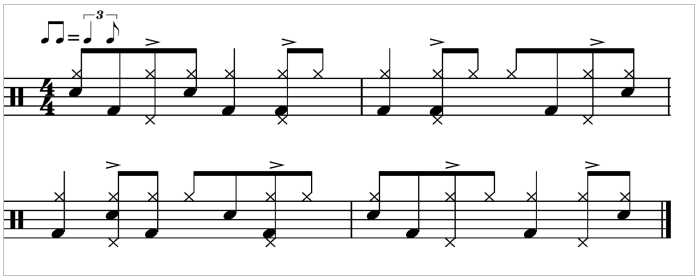
This is just one way we can use simple reading text to help us to develop our musicality on the drumkit. The most common reading text that drummers use is Syncopation for the Modern Drummer (REED, T). I always suggest that students at JMI purchase this as it will serve you well in your studies in Jazz.
